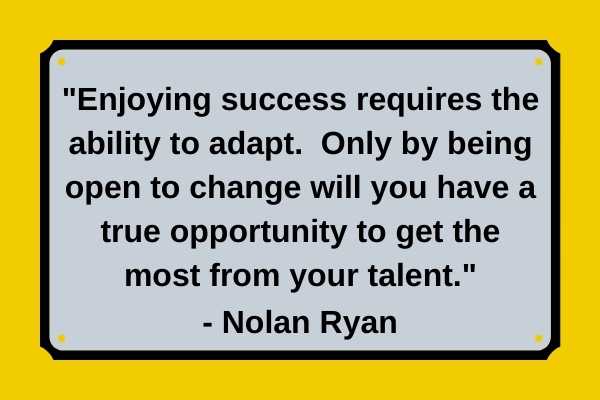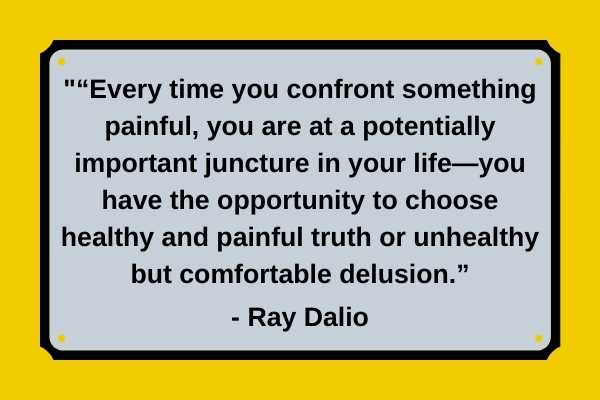To develop great teams, try giving thoughtful feedback in the workplace. These tips will help you sound less like a jerk when providing valuable and effective team feedback.
Team feedback is such a critical part of team building. Yet most authors shy away from it, and we certainly shy away from it in general. Ray Dalio has done the opposite and drove headfirst right into the wall of “what is”! Right we’ve all heard it: ADAPT OR DIE! What does this really mean?
 This is a three-part series on how to develop great teams.
This is a three-part series on how to develop great teams.
Part I – How to Develop Great Teams: the Foundation
Part II – How to Develop Great Teams: Implement the Tools
Part III – How to Develop Great Teams: Feedback in the Workplace (this post)
Ever notice, if you are inquisitive, sometimes people get defensive about the innocent inquiry? Perhaps because it makes them think.
At least that’s what people have admitted to me. They just want to chill out, skate by, do the bare minimum. To think is “hard,” they tell me. A real pain in the….! Some people become irritated when they are challenged to tune in and really think!
Here’s the thing though, stagnation is like a slow death. It can depress ‘go-getters’ and that’s often why they are most often “going”! If we feel stuck or held back it won’t be for very long! For us growth = life, which is good because, in reality, growth is life.
“Evolution is the single greatest force in the universe; it is the only thing that is permanent and drives everything.”- Dalio
Giving Team Feedback in the Workplace
 One big thing that stood in the way to success was a lack of understanding of “what is”.
One big thing that stood in the way to success was a lack of understanding of “what is”.
An error in my thinking that because I thought a certain way, I assumed others thought in this same way. While intelligent by some metrics, I was also very naïve in others.
Can you relate?
I incorrectly assumed that most wanted to grow or valued relationships as much as I did. Ignorantly, I did not realize that most people have little interest in doing what is uncomfortable in order to grow. I did not understand what lengths people would go to avoid earnest self-assessment.
The irony is “pain avoiders” are actually very strong. It takes great will and strength to endure the same pain over and over and over again in the hopes to avoid the pain of just looking at self and squaring up! So why avoid a one–time pain event for a repeat pain event? What turns the seemingly might human into a real whimpering pup when it comes to honest self-appraisal? That’s an entirely new blog post! But here’s a little glimmer.
“People almost always find it difficult to identify and accept their own mistakes and weaknesses. Sometimes it’s because they’re blind to them, but more often it’s because their egos get in the way.” – Dalio.
Dalio made billions. Doubtful anyone will read his book, practice his principles fervently and also make billions. Of the 7.7 billion population only about 2,100 are billionaires. So, if that is the motivation behind doing the work, almost all will fail. However, anyone that seeks growth in earnest can certainly evolve and mature; which in turn can make one more successful, a more effective leader and in turn probably lead to more profit.
So, if you are ready for the journey, there is a great Harvard article our 7H facilitator sent over for us. We are currently working on getting feedback from our team, personal feedback, on how well we are living in our own mission statement. Fun times people, fun times!
“The debate about feedback at work isn’t new. Since at least the middle of the last century, the question of how to get employees to improve has generated a good deal of opinion and research. But recently the discussion has taken on new intensity. The ongoing experiment in “radical transparency” at Bridgewater Associates and the culture at Netflix, which the Wall Street Journal recently described as “encouraging harsh feedback” and subjecting workers to “intense and awkward” real-time 360s, are but two examples of the overriding belief that the way to increase performance in companies is through rigorous, frequent, candid, pervasive, and often critical feedback. – The Feedback Fallacy – A version of this article appeared in the March–April 2019 issue (pp.92–101) of Harvard Business Review.
So, what is really true? First, what is feedback really? We have all probably had people who gave their opinions, pointed out our faults, criticized, belittled or judged us harshly! This is NOT the feedback we are speaking of here.
How to Give Feedback to Team Members
 NOT FEEDBACK:
NOT FEEDBACK:
“Jessica your emails are too long and confusing. I have no idea what you want and often have to read them several times.”
VALUABLE FEEDBACK:
“Jessica your input is valuable. I am not sure sometimes what support you are looking for in how you convey feedback in emails and I’d really like to make sure I’m supporting you! Can we work to get in sync?”
First, Jessica is going to feel valued. Second, Jessica is going to feel you intend to support her, not attack her and make her wrong. Third, Jessica is being invited into a team collaboration session where she is empowered to be a part of the solution!
You may have to take time to really think about how you deliver your feedback, and this is going to be time well spent!
In this example, it’s clear what the issue is, and that’s a good first step in giving feedback, but it’s not enough. We MUST also train ourselves to be clear on what we want so the person getting the feedback has a real goal to work toward.
“Jessica, what are some ways you could be more concise in email?”
This allows Jessica to be engaged in her own development. If Jessica is not sure, or can’t understand the feedback then give her a very clear example.
“Jessica here is your email.”
There are too many widgets and they get lost. Just yesterday I spent hours looking and even went to the guard shack and asked around but no one could find them. I emailed inventory as well and they are not there. We have lost so many this year and they are expensive. We think we might clear away space in the back area to store them. We need to figure out where they went and to stop losing them.
“Jessica here are some questions I ask myself when drafting an email.”
- What is the problem
- Give clear metrics
- What is the solution or some solutions?
- What do I want from the person getting the email?
“Jessica, how would you rewrite your email based on the above?”
Hi,
Suggested inventory control system for approval or further discussion:
- We lose too many widgets.
- Last quarter we lost 75 at a cost to us of $8,973
- Recommend we set up the back room with a sign-out sheet for people when they remove widgets.
Now Jessica has a real tangible “how-to” in which to follow. It will change her thinking and give her a clear outline of how to better organize her thoughts. This is FEEDBACK that is productive and the purpose of feedback can be about helping you develop how to be clear so that you can teach others how to be clear!
Feedback is NOT about tearing down a person, it is about coaching them up. If you don’t know how to coach people up and clearly state to them what you are looking for, then how can you expect them to clearly state what they want?
This is the number one pitfall of real constructive feedback.
People confuse feedback with criticism.
“Jessica your emails are a waste of time and too long” is NOT FEEDBACK. It’s just a rude statement, that will most likely be received as an attack or cause hurt feelings. This is NOT radical truth, this is just laziness and poor manners.
So for feedback to be effective the person giving it must be effective!
To give valuable feedback, follow some simple etiquette rules:
- Make sure to show appreciation for the other person.
- What is the problem? Focus on the results and not the person or their characteristics.
- Make your intentions clear.
- What are you looking for – begin with the end in mind – A great Covey tool.
Using the Above Example:
- “Jessica your input is valuable.
- I am not sure sometimes what support you are looking for in how you convey feedback in emails
- and I’d really like to make sure I’m supporting you!
- Can we work to get in sync?”
Now, not everyone is going to be so thoughtful in how they give feedback. So what! You can learn to be thoughtful in how you deliver it! This will help you grow professionally and lead to a better culture and might even transform those you work with into a different way of working!
Receiving Harsh Feedback
So now let’s look at how to receive harsh feedback.
“Jessica your emails are too long and confusing. I have no idea what you want and often have to read them several times.”
Let’s say you are not exactly sure what this person would like from you, but you are willing to use this as an opportunity for your own leadership development!
A response could look like this:
“I appreciate your feedback. Can you share a specific example and how I could have done this differently to be more clear? I want to be in sync and thoughtful of our time. Do you have suggestions on how I could improve?”
Now, what if they just say “I don’t know what to tell you except get to the point.”
 This may seem like a tall order, that first they are pretty thoughtless in how to deliver their feedback and now they are unwilling to take time to work with you! In reality, this is most people. So at this point, it’s a good time to decide “do I want to feel hurt, feel wronged, feel right in my upset, or do I want to grow and move the F on?”
This may seem like a tall order, that first they are pretty thoughtless in how to deliver their feedback and now they are unwilling to take time to work with you! In reality, this is most people. So at this point, it’s a good time to decide “do I want to feel hurt, feel wronged, feel right in my upset, or do I want to grow and move the F on?”
“The most valuable habit I’ve acquired is using pain to trigger quality reflections. If you can acquire this habit yourself, you will learn what causes your pain and what you can do about it, and it will have an enormous impact on your effectiveness.”
― Ray Dalio, Principles: Life and Work
To grow, we must strengthen our emotional muscles. We do this by choosing to see where others may have a point, find out if there is something from their point, swallow a little crow maybe and move along the emotional intelligence spectrum even if the person delivering the message has a low EQ. In reality, how many people do you actually interact with that have a high EQ? If the answer is “not many” then consider why then do you expect people to act with a high EQ and to get bent when they don’t? Is that not a contradiction in your own thinking? If you believe most people have a low EQ but expect feedback or behavior that comes from a high EQ place, that’s a schism in your own thought paradigm.
So instead, expect people to be what you expect them to be and not what you wish they were! Then ask yourself “how can I show up how I wish they would?”
Ironically team culture is often a culture of ONE – You! If you embody all that you seek from others every single day to the best of your ability you will be amazed at how transformative it will be in your own interpersonal relationships.
One cautionary note, don’t be a people pleaser and chase the naysayers! No matter how hard you try, someone committed to being a jerk is going to be a jerk! Sometimes the best thing is to ignore them, humor them, avoid them, defuse them (if you’re talented enough in this area) or even just call them out on their ‘jerkiness’ and move on.
That’s another blog post “How to deal with jerks without becoming one!”
The FIRM is here to help with team development by offering team building activities at our 420-acre motorsport park! Learn more about hosting a team building event at The FIRM.










